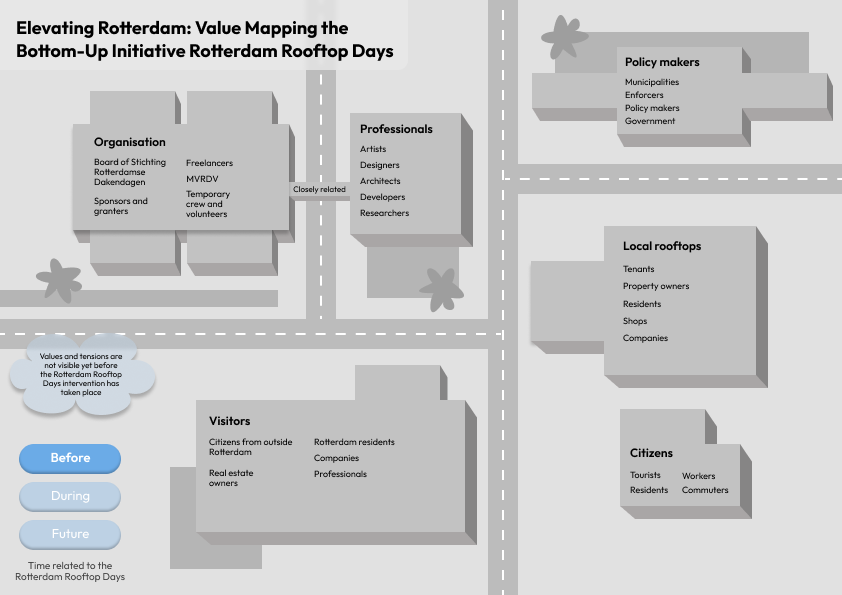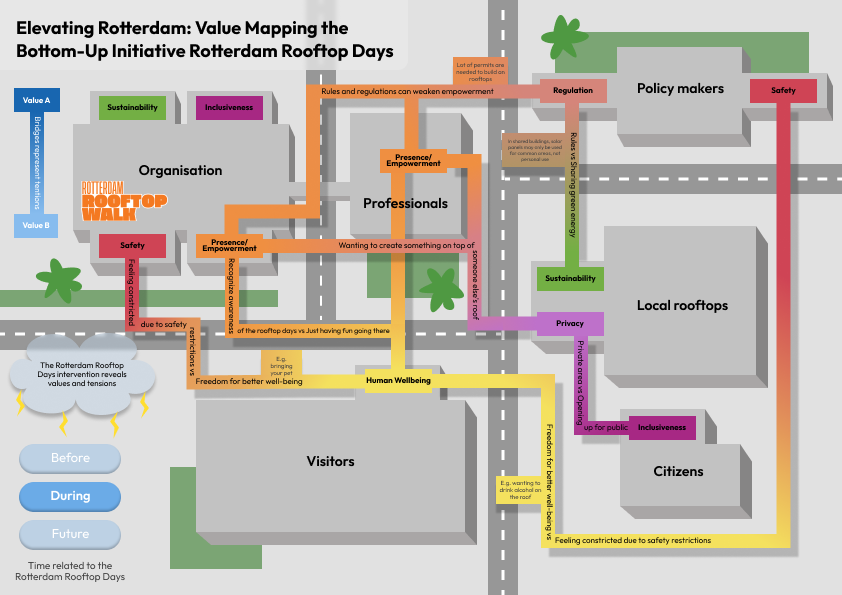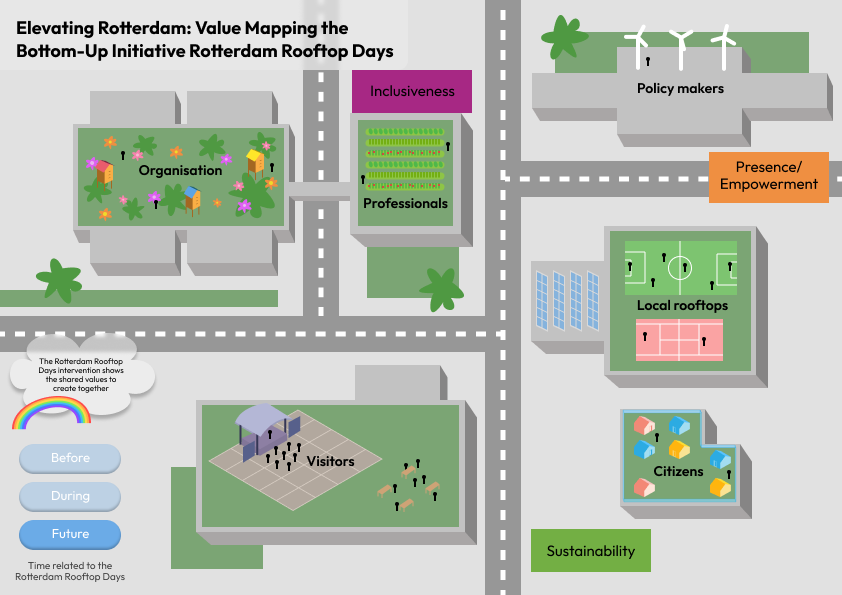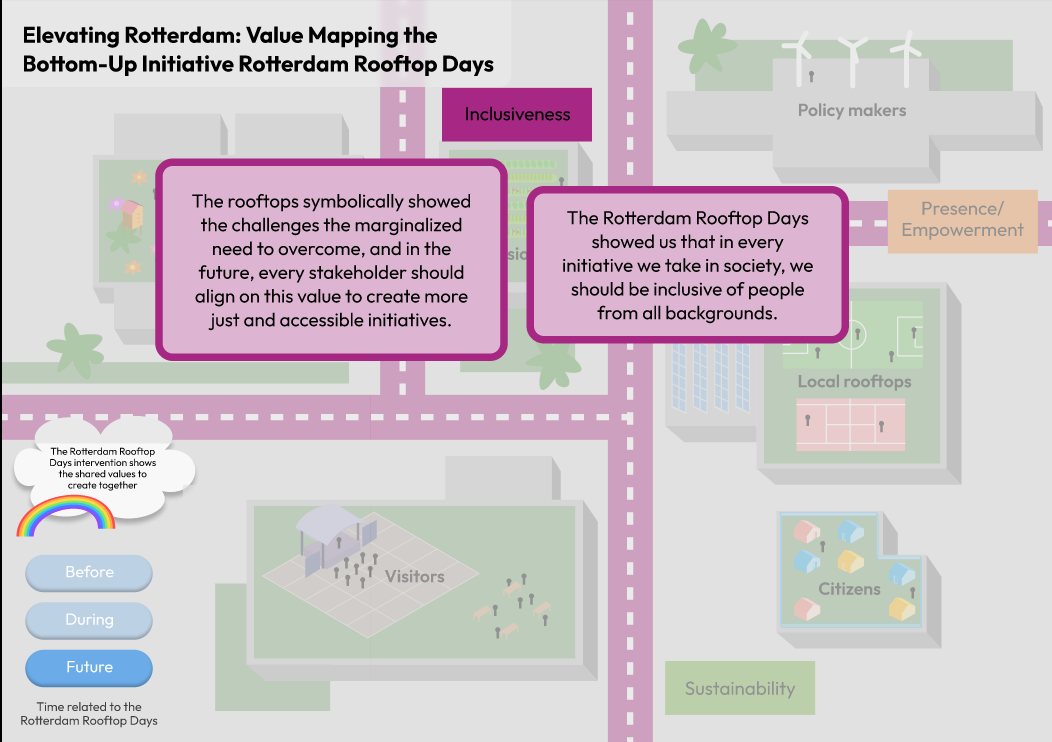Elevating Rotterdam: Value Mapping the Bottom-Up Initiative Rotterdam Rooftop Days




This map represents the values of the initiative Rotterdam Rooftop Days (Rotterdamse Dakendagen in Dutch). In this now yearly recurring event that takes place within the port city of Rotterdam, visitors were allowed to travel through all kinds of innovative interventions on how rooftops are used now or how they could be used in the future. Temporary installations were built on top of a variety of rooftops of the city to highlight the vast amount of unused space. The main goal of this initiative is to increase awareness of the potential of rooftop spaces, which could serve as a 'second layer' to create more liveable, biodiverse, sustainable, and healthy cities. Therefore, it can help to tackle major challenges like climate change, the housing crisis, and the transition to renewable energy (MVRDV, n.d.-b).
The Bauhaus of the Seas Sails project encourages designers to shift to designing complex interactions that bring about a critical awareness of modern-day practice and future possibilities (Bauhaus of Seas, 2023). This aligns neatly with the Rotterdam Rooftop Days, as the organization wants to open up debate and present innovative possibilities. Artists, designers, and architects were involved in creating the exhibition and made professional city makers (real estate owners, developers, policymakers, etc.) aware of the possibilities of rooftops. Showing what is possible and raising awareness was positioned as the first step toward reinforcing behavior and putting the roofs into use.
The Value Map is customized to the specific context of its main focus, the port city of Rotterdam. It showcases the stages 'before', 'during', and 'future' of the Rotterdam Rooftop Days initiative. The temporal nature of this initiative was one of the factors in choosing it as the focal point of the Value Map, as it highlights a direction for design that goes beyond solution-based and explores other roles, such as critique and raising awareness.
Before
The 'before' phase of the Value Map, seen in Figure 11, shows a spectrum of actors, from policymakers to residents, all influencing the dynamics of the city but not working cohesively. The rooftops, as depicted in the 'before' phase, remain unused and empty, a striking symbol of wasted space and untapped potential. The rendering in shades of gray visible in Figure 1 serves as a grim reminder of the under-utilization of this urban canvas.
During
The 'during' phase of Rotterdam's Rooftop Days showcases the transformative impact of key values such as Sustainability, Inclusiveness, Presence/Empowerment, Safety, Human Well-being, Privacy, and Regulation on stakeholders and the urban landscape. The vibrant use of colors highlights the trade-offs and conflicts inherent in value-driven transitions, resembling the vibrant nature of the initiative (fig. 2).
Future
The 'future' phase, as seen in Figure 3, reflects the shared vision and commitment of stakeholders to work toward a better, more sustainable, inclusive, and empowered urban environment. The emphasized values of Sustainability, Inclusiveness, and Presence/Power capture the essence of the collective vision for the ‘future’. By clicking on these values more information is given (fig. 4). These choices, inspired by The Rotterdam Rooftop Days, highlight the importance of aligning stakeholders with these values to create lasting and positive change in port cities.
The role of design in mission-driven innovation was examined through the professional practices of expert designers in the Rotterdam Rooftop Days as a discrete organization, as well as the diffuse design skills and mindset of other collaborators, including visitors. This spectrum of design capabilities made the many layers, classifications, and embodiments design can take on in urban innovation further clear. The stakeholder mappings made this more explicit while simultaneously highlighting the significance of various ways of designing together (co-design, participatory design, etc.).
The initiative and its material embodiment in the form of temporary rooftop structures can be likened to a symbolic representation of how design can go beyond solutionism and take on new roles. The structures do not serve any intrinsic purpose in the city context; they are temporary and meant to be taken down, yet, they posit a reference point to initiate dialogue and criticism. It appears that design can also be positioned as a catalyst for change rather than create the change itself.
